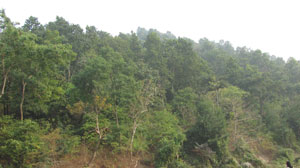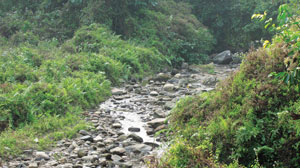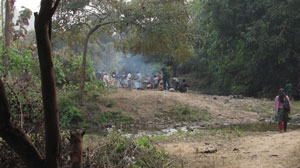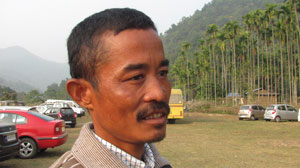The Shankarghola Initiative
Shankarghola Shows the Path of Regenerating Forest

It is a bright winter noon and Bamuni Rabha, wife Hemanta Rabha and a mother of two in Shankarghola village is happy to get
an order to cook an indigenous Rabha cuisine for a group of tourists visiting Shankarghola reserve forest. As she is ready to prepare the meal for the tourists, her husband Hemanta Rabha gets himself busy collecting revenue from the different groups that have entered into Shankarghola to enjoy a picnic party with family and friends. It is, in fact, an idea that the villagers have developed to collect a small amount of money as revenue from every picnic group that enters the Shankarghola reserve forest.
The tale of Bamuni and her husband is not a singular story of earning something from tourists, rather the it has a deep connection with efforts of the villagers that have spanned years to revive a forest, once degraded due to massive human activity.
Though illiterate, today Bamuni, like her fellow village women, is well-versed in conservation of nature and the  possibilities of eco-tourism in the vicinity she has been surviving throughout the ages, thanks to the initiative of a group of nature-lovers who initiated a conservation process years ago.
possibilities of eco-tourism in the vicinity she has been surviving throughout the ages, thanks to the initiative of a group of nature-lovers who initiated a conservation process years ago.
For the past fifteen years or so, the tribal people of Shankarghola have been maintaining the lush green of mixed moist deciduous forest cover of their ancestral village and making this a Community Conserved Areas (CCA) for forest ecosystems which has become a huge success story in the country. Serene and remotely situated in Uttar Salmara subdivision of Bangaigaon district in lower Assam, Shankarghola is a safe haven for at least five troops of sonali Bandar, or Golden Langur - a species already enlisted as ‘critically endangered’ by IUCN red-list. The forest shelters a population of over 52 Golden Langurs. Other faunal species of the reserve forest, with a tiny geographical area of less than 10 square kilometers include wild boars, leopards, porcupines, barking deer and over 35 avian species - both resident and migratory.
Shankarghola with 62 families belonging to the Rabha tribe, and a small population of Bengali families, mostly agrarian - is literally a plastic - bag free zone and is engaged in the organic mode of agricultural practices. Each of these families is not only aware of why and how conservation of floral and faunal resource of their locality is important, but also how to survive utilizing the best of local resources.
 The picture, however, was no this encouraging till the early part of the nineties. Low socio - economic conditions of the people, non-remunerative agriculture, livelihood risks and ignorance of how to manage natural resources forced them to indulge in illegal felling of trees that were considered as the main fodder tree of the Golden Langur. “Not only trees, even, the endangered Golden Langurs too, were not spared. The most endangered mammal species were sold indiscriminately in the market for human consumption for just Rs.100/ per piece, before we reached here and initiated a project titled ‘Community Participation in Golden Langur Conservation Project’, mainly because of ignorance regarding wildlife act,’’ says Ashoke Kumar Das, Coordinator, West Assam Zone of Aranyak, an organization engaged in wildlife protection since 1989, who also teaches in Abhayapuri College.
The picture, however, was no this encouraging till the early part of the nineties. Low socio - economic conditions of the people, non-remunerative agriculture, livelihood risks and ignorance of how to manage natural resources forced them to indulge in illegal felling of trees that were considered as the main fodder tree of the Golden Langur. “Not only trees, even, the endangered Golden Langurs too, were not spared. The most endangered mammal species were sold indiscriminately in the market for human consumption for just Rs.100/ per piece, before we reached here and initiated a project titled ‘Community Participation in Golden Langur Conservation Project’, mainly because of ignorance regarding wildlife act,’’ says Ashoke Kumar Das, Coordinator, West Assam Zone of Aranyak, an organization engaged in wildlife protection since 1989, who also teaches in Abhayapuri College.
The results of such indiscriminate human activities became visible within a short span of time when these local people experienced that the ever - flowing stream Kanglakati, floating down the hills of Shankarghola and the lifeline of traditional agriculture practices of the area dried up. These people had a traditional and eco - friendly system of making irrigation provisions to their paddy - fields from this stream. With the gradual drying up of the stream, this innovative irrigation system also got hampered putting the villagers in severe crisis.

The approach of Aranyak awareness and conservation programme was two - fold. It initiated the efforts of the community people in the regeneration of plant species, particularly those considered to be the fodder of the Golden Langur. Simultaneously, it initiated a viable livelihood plan on the basis of traditional skills and knowledge of the people including that of honey - bee keeping, piggery, weaving, bamboo craft etc. The villagers were also educated about eco - tourism.
The regeneration gradually helped in the revival of the hills and to their surprise, the stream too, became perennial once again. This made the villagers confident about their approach of conservation. A water body, Dolony Beel, in which the stream meets, and which has again, connection with the mighty river Brahmaputra, is an added attraction for tourists interested in boating at this serene place. With an increasing number of tourists visiting the village, the forest cover and he water - body have encouraged the local people to improve the existing infrastructure.
“If you are lucky, you may even spot the Golden Langur, in our campus today, as we have planted fodder trees for them in our campus too,” says a contended Hemanta. He is happy that there is a steady and increasing inflow of tourists to the area. The reserve forest is situated at a convenient distance from both Guwahati and Bangaigaon railway station and a one night stay is enough to enjoy some quality time amidst lush greenery.
The Golden Langur is found only in a confined geographical location of less than 30,000 square kilometers in India and Bhutan. The estimated population in India is less than 1,500. Another 4,000 of them survives in Bhutan. “Fortunately, we could identify a few educated youth like Hemanta Rabha, who was studying in Abhyapuri College that time and became the driving force of our conservation process. With Hemanta’s help we could motivate a handful of village youth initially, which was a great achievement initially. This group is still active and awareness regarding conservation has been spread to surrounding villages. Gradually, we approached the administration to improve surface connectivity to check illegal tree - felling activities and making arrangements for better livelihood for the villagers,” says Hilloljyoti Singha, Assistant Professor of Assam University, Silchar, who has been associated with the conservation process of Shankarghola from the beginning and also directed the project.
Skahkarghola is a classic example of how timely and proper intervention of agencies, administration and the involvement of the community can make conservation efforts a huge success. However, nature lovers like Hilloljyoti and Ashoke feel that there is still a long way to go with many challenges ahead. The Aranyak team has a road - map for eco - tourism promoting home - stay arrangements and has also submitted proposals to institutions like NABARD and Assam Tourism with hopes of a good result so that the villagers get the maximum benefit out of the process.
At least eight CCAs for forest ecosystems and another six CCAs for wet - land, coastal and marine habitats have been surviving in our country by community conservation efforts. In the North East States, the examples of how indigenous people in Nagaland have been conserving a people’s sanctuary for the endangered Blyth’s tragopan in Khonoma village; regeneration of 600 hectares in catchment areas of Loktak lake in Tokpa Kabui village of Churachandpur district in Manipur, and the efforts of Khasi people living in hills of Meghalaya for traditionally protecting sacred grooves, can be cited as success stories of CCAs, in addition to the Shankarghola initiative.


